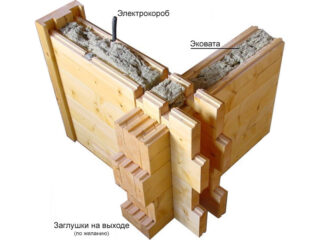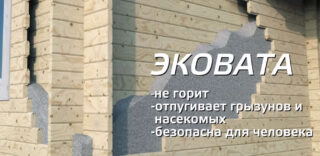A house made of double timber has two-layer walls with an insulation pad inside - ecowool or mineral wool. The structure is based on profiled timber. The technology appeared in Russia quite recently. She came to us from Finland and aims to minimize the transfer of heat to the external environment.
Advantages and disadvantages of double timber houses
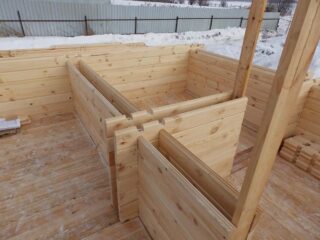
Houses made of double timber attract with their appearance - the material has a flat surface and an attractive texture, does not require subsequent cladding. Due to the low weight during construction, you do not need to spend money on a massive foundation. Other advantages of such buildings include:
- Excellent thermal insulation performance, which helps to reduce heating costs in winter.
- The speed of construction, no need for special equipment.
- Possibility of installation of hidden wiring in the wall thickness.
- Weak shrinkage, which is explained by preliminary drying of the feedstock. As a result, sometimes tenants prefer to move in a house immediately after construction. But it's better to wait six months.
- Double locks on structural elements that ensure their strong adhesion to each other. Thanks to this, the walls are not blown by the wind.
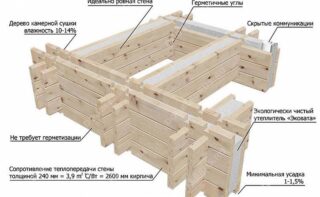
For the price, the construction of such a building will cost more than a frame or log house, but cheaper than a dwelling made of laminated veneer lumber. The walls turn out to be rather thin, with insulation making up more than half of their thickness. For example, with a total value of 22 cm, 9 cm will be for wood, 13 for mineral wool. Due to this, the building is lightweight. If the soil is not “problematic”, it can be built even on a shallow strip foundation. But if it is characterized by flowability or instability, it is worth choosing screw piles.
The main disadvantage of this technology is the uneven shrinkage. Explained by the structure of the walls. Due to the different conditions (temperature, humidity) in the dwelling and outdoors, the outer and inner layers of the tree come into contact with the environment in different ways. There may also be a difference in shrinkage between areas in the shade and in the sun. This phenomenon is more pronounced in multi-storey buildings. Insulation in such cases can spill out into the cracks inside the building. This phenomenon can be prevented by introducing stricter requirements for the condition of the original sawn timber.
Only carefully dried timber treated with antiseptic compounds should be purchased. It is best to choose kiln-dried materials. Before construction, it is recommended to consult whether this technology is suitable for the climate of the area where the house will be built. Frequent and sharp jumps in temperature, especially transitions from frost to an indicator near zero, contribute to cracking of the timber and other deformations.
The technology is distinguished by its exactingness to insulation and installation method. Not all of the materials used for thermal insulation common on the market are suitable. The insulation should be environmentally friendly, not prone to subsidence or caking after several years of operation. Such requirements are explained by the fact that it is rather difficult to replace material that has become unusable with this technology. Correct installation of insulation is also important. It is introduced in stages: after collecting a meter of the height of the building, cutoffs are mounted into the gaps and ecowool is blown into it. It happens that during construction they try to blow in an entire wall several meters high in one go.This will certainly soon entail shrinkage of the insulation.
Due to the ease of linking the elements to each other, it may seem that it is easy to assemble such a house alone. However, the technology has a number of nuances, non-observance of which exacerbates the problem of uneven shrinkage. With a lack of skills in this area, it is better to invite a team with extensive experience in construction.
Double timber house projects
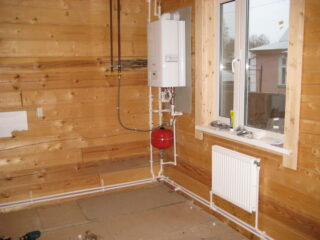
The technology makes it possible to erect buildings according to various projects - from small country houses to high-rise buildings with annexes. When choosing, the purpose of the building, the composition of the family, the characteristics of the soil and climate, as well as financial capabilities are taken into account.
If it is decided to build a house on two or more floors, you need to take care of strengthening the foundation sufficient for this task. Experts will help to calculate the required load.
When planning heating, remember that timber is a combustible material. The best option would be to install electric heaters, during the operation of which the user does not have to deal with an open fire. If a stove or fireplace is chosen, during installation, you need to carefully consider fire safety standards.
Construction technology
Having decided on the project, you can start laying the foundation. Before working with wood, it is necessary to lay waterproofing on the base.
The lower level of the walls is installed from the timber on the slats. The detected cracks are sealed with polyurethane foam. The subsequent process of building walls is similar to assembling a constructor.
It is important to take care of the processing of the material with an antiseptic.
Thanks to well-thought-out locking joints, when fixing the beams, you do not have to use adhesives and nails.
Workers carry out the installation of insulation using special equipment.
When the walls are ready, you can install the rafter system and lay the roof.
Insulation materials used
The best choice for this task would be ecowool. It is blown out in several steps between the inner and outer walls. It is not required to ram it. This installation forms a layer of natural density material. It is important to correctly calculate the required amount of cotton wool when the thermometer reads above zero. If there is too much material, the walls will deform in frost. If it is not enough, the thermal insulation will be insufficient.
The finished timber has a flat surface and an attractive appearance, so no additional wall cladding is required from it. Sometimes they are left without any additional finishing. Most often they are glazed and tinted. The result is complex iridescent shades.

